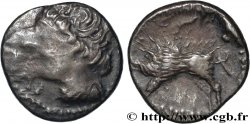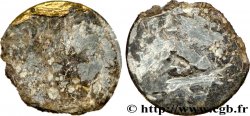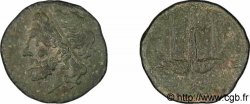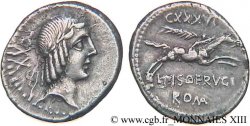v15_1370 - HELVETI (Current Switzerland) Statère de Philippe II, imitation celtique
MONNAIES 15 (2002)
Precio de inicio : 950.00 €
Valoración : 2 000.00 €
Precio realizado : 950.00 €
Precio de inicio : 950.00 €
Valoración : 2 000.00 €
Precio realizado : 950.00 €
Tipo : Statère de Philippe II, imitation celtique
Fecha: IIe-Ier siècles avant J.-C.
Metal: oro
Diámetro: 18 mm
Eje de acuñación: 1 h.
Peso: 7,96 g.
Grado de rareza: R3
Comentarios sobre el estado de conservación:
Exemplaire sans frai apparent mais recouvert de stries, au droit et au revers, qui font fuser les reliefs. Plusieurs imperfections de frappe. Frappe faible au revers et coup ou paille de métal sur l’aurige
Anverso
Titulatura del anverso: ANÉPIGRAPHE.
Descripción del anverso: Tête laurée à droite, imitant la tête d’Apollon.
Reverso
Descripción del reverso: Bige galopant à droite, les chevaux bondissant, avec un objet indéterminé sous les pattes avant. L'aurige, au-dessus de la roue du char, tient un fouet. Traces de légende, mais pas de ligne d’exergue.
Leyenda del reverso: [fILIPP.U]
Comentario
Ce statère dont le revers est difficilement lisible semblerait appartenir à l’émission AP, foudre et épi. Comme sur l’exemplaire du musée de Lyon (Sch/L. 300), on semble distinguer un trait qui s’arrête au menton avec un motif décoratif au milieu du cou en forme de boucle. Au revers, tous les symboles semblent comme absents, fortement martelés ou flous. Un trait semble barrer l’arrière de la nacelle du char. Notre exemplaire, avec un poids léger, n’est pas incompatible avec la série car l’exemplaire du musée de Luxembourg ne pèse pas plus (7,96 g). Notre exemplaire n’est pas sans présenter une homotypie de contiguïté avec le type des statères décrits par Allen (RSN. 1974, pl. II, n° 36-37 qui présentent la particularité d’avoir le visage barré d’un trait et qui sont réputés provenir de la trouvaille de Craon dans la Mayenne. Le statère de Philippe II, ayant reçu un coup de cisaille afin de le démonétiser (cf. Musée de Clermont-Ferrand, p. 23, n° 983-18-1, LT. 6410) est réputé avoir été trouvé dans les environs de Chartres. L’attribution aux Helvètes est possible, mais pas certaine, pas plus que celle aux Arvernes ou bien encore une hypothétique attribution aux Carnutes.
This stater, the reverse of which is difficult to read, appears to belong to the AP issue, lightning and ear of corn. As on the example in the Lyon museum (Sch/L. 300), we seem to distinguish a line which stops at the chin with a decorative motif in the middle of the neck in the shape of a loop. On the reverse, all symbols appear to be absent, heavily hammered or blurred.. A line appears to cross the rear of the tank's nacelle. Our example, with its light weight, is not incompatible with the series because the example in the Luxembourg museum does not weigh more (7.96 g). Our specimen is not without presenting a homotypy of contiguity with the type of staters described by Allen (RSN. 1974, pl. II, no. 36-37 which have the particularity of having a face crossed out and which are reputed to come from the find at Craon in Mayenne. The stater of Philip II, having received a blow from the shears in order to demonetize it (cf.. Clermont-Ferrand Museum, p. 23, No. 983-18-1, LT. 6410) is said to have been found in the vicinity of Chartres. The attribution to the Helvetians is possible, but not certain, no more than that to the Arverni or even a hypothetical attribution to the Carnutes
This stater, the reverse of which is difficult to read, appears to belong to the AP issue, lightning and ear of corn. As on the example in the Lyon museum (Sch/L. 300), we seem to distinguish a line which stops at the chin with a decorative motif in the middle of the neck in the shape of a loop. On the reverse, all symbols appear to be absent, heavily hammered or blurred.. A line appears to cross the rear of the tank's nacelle. Our example, with its light weight, is not incompatible with the series because the example in the Luxembourg museum does not weigh more (7.96 g). Our specimen is not without presenting a homotypy of contiguity with the type of staters described by Allen (RSN. 1974, pl. II, no. 36-37 which have the particularity of having a face crossed out and which are reputed to come from the find at Craon in Mayenne. The stater of Philip II, having received a blow from the shears in order to demonetize it (cf.. Clermont-Ferrand Museum, p. 23, No. 983-18-1, LT. 6410) is said to have been found in the vicinity of Chartres. The attribution to the Helvetians is possible, but not certain, no more than that to the Arverni or even a hypothetical attribution to the Carnutes








 Informar de un error
Informar de un error Imprimir la página
Imprimir la página Comparte mi selección
Comparte mi selección Haz una pregunta
Haz una pregunta Consignar / vender
Consignar / vender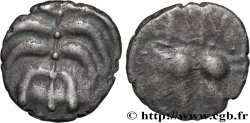
 Descriptivo
Descriptivo